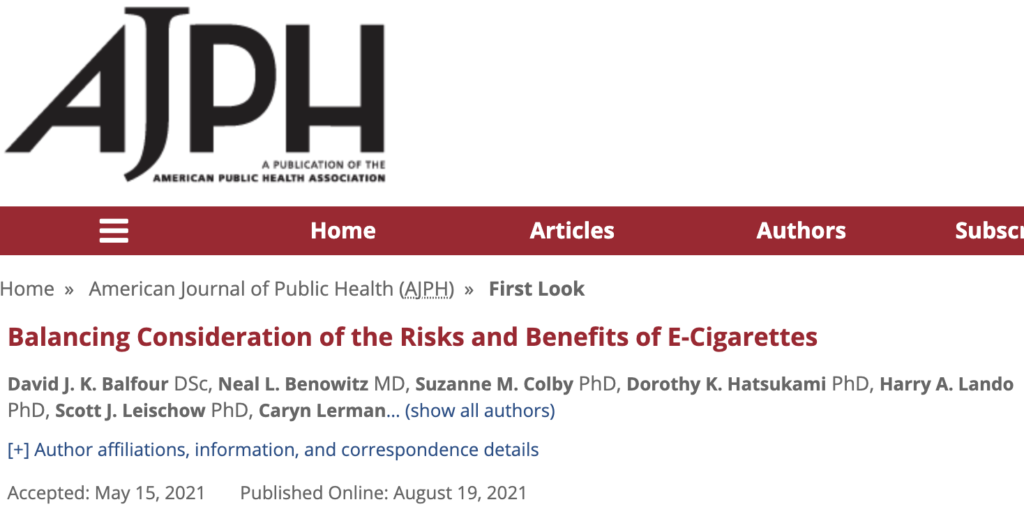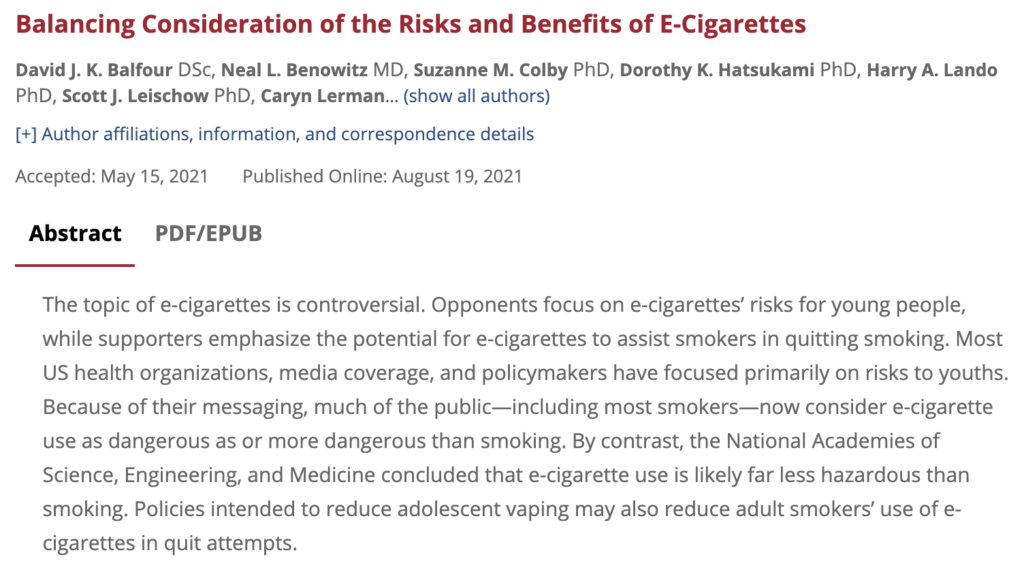In a article published in the “American Journal of Public Health”, the nation’s most influential tobacco control experts come together to endorse the harm-reduction benefits of E-cigarettes use for adult smokers, call for its public image to be restored, and highlight its ability to save lives as a safer alternative to combustible cigarettes.

Media “Filter,” says the paper represents the most articulate and clear-cut call to date by such scholars.

The article argues that public understanding of e-cigarettes has been poisoned by powerful interests that exaggerate the risks to young people and largely ignore the potential benefits of e-cigarettes for smoking adults.
“Tobacco control organizations and the media that control one-sided conversations have lost sight of the existence of adult smokers as a group.” The authors say.
About the authors: 15 top tobacco control experts join forces

The article, published in the “American Journal of Public Health”, was co-authored by 15 past presidents of the Society for Research on Nicotine and Tobacco (SRNT), led by Kenneth Warner, professor emeritus and dean of the University of Michigan School of Public Health and a distinguished tobacco control expert.
Fifteen individuals co-signed the paper, each of whom has served as a past president of the Society for Research on Nicotine and Tobacco (SRNT), the preeminent scientific professional association focused on nicotine and tobacco.
They include Dr. Neil Benowitz, professor of medicine at the University of California, San Francisco (UCSF) and one of the world’s leading experts on nicotine addiction; Dr. Robin Mermelstein, director of the Institute for Health Research and Policy at the University of Illinois at Chicago and chair of the FDA Scientific Advisory Committee on Tobacco Products; and Dr. Nancy Rigotti, founder and director of the Center for Tobacco Research and Treatment at Massachusetts General Hospital in Boston.
Of the past 26 SRNT chairs, one could not be located and three declined to participate because they perceived a conflict of interest. This means that of the 22 remaining past presidents, only seven did not sign their names, and means that more than two-thirds of the most respected and respected tobacco control experts believe e-cigarettes should be considered a form of harm reduction.
Filter Media said these are all household names in the tobacco control community. None of them can be accused of being tobacco or e-cigarette shills, nor can they be dismissed as non-experts.
On the topic of the article: Balancing the risks and benefits of e-cigarettes
The paper talks about how the topic of e-cigarettes is controversial. Opponents are concerned about the risks of e-cigarettes to young people, while supporters emphasize the potential of e-cigarettes to help smokers quit. Most U.S. health organizations, media reports, and policymakers focus primarily on the risks to young people. As a result of their messages, many members of the public (including most smokers) now believe that e-cigarette use is as dangerous as, or more dangerous than smoking.
In contrast, the National Academies of Sciences, Engineering, and Medicine have concluded that e-cigarette use may be far less harmful than smoking and that policies aimed at reducing e-cigarette use among youth may also reduce e-cigarette use among adult smokers in their quit attempts.
Because of the evidence that e-cigarette use increases the odds of quitting, many scientists, including the authors of this paper, encourage the health community, the media, and policymakers to weigh more carefully the potential of e-cigarettes to reduce adult smoking mortality.
The paper reviews the health risks of e-cigarette use, the potential for e-cigarettes to increase smoking cessation, concerns about e-cigarettes in adolescents, and the need to balance legitimate concerns about the risks to adolescents with the potential benefits of increased smoking cessation in adults.
The article addresses everything from confusion about the effects of nicotine on the developing brain to how we should balance concerns about the risks and potential benefits of e-cigarettes. It should serve as a much-needed corrective to the swirl of misinformation surrounding e-cigarettes.
News has overwhelmingly focused on the risks of e-cigarettes to young people. The public has been led to believe that e-cigarettes are as harmful or more harmful than smoking when the opposite is true.
“We are concerned that many in the public health community – the media, of course, and many lawmakers – are not hearing the other side of the story,” Warner told the media. “Frankly, we hope that the origins of the paper and the authors of the paper will raise some serious concerns.”
This is an extremely rare statement, one that critics will have a hard time dismissing with the usual accusations (such as being a corporate shill or not looking out for the children).
The co-authors themselves are arguably the most important part.
The conversation around tobacco harm reduction (THR) is often dominated by two vocal factions. Bloomberg, who funded the push for a ban on e-cigarette product flavors, and then consumer advocates, manufacturers, former smokers, and drug war critics, who have made evidence-based arguments that draconian legislation on safer nicotine alternatives such as e-cigarettes would lead to smoking deaths.
Tobacco use remains the NO.1 preventable cause of death.
Public health agencies and anti-tobacco groups that control the e-cigarette discussion simply do not consider the lives of adults who smoke as part of the discussion.
E-cigarette media “Vaping360” believes that while the primary value of this paper lies in the reputation of those who wrote it, it also serves as a very concise literature review that presents the evidence on both sides of most of today’s major e-cigarette issues in an easy-to-read format for deadline reporters.
The authors cite the growing evidence from clinical and population studies that e-cigarettes help smokers quit; they describe the recent decline in cigarette sales corresponding to the increase in e-cigarette adoption; and they note that policies that reduce the attractiveness of e-cigarettes (e.g., taxes) increase smoking, making both practices economically substitutable.
They dispute evidence that e-cigarettes are contributing to the epidemic of youth nicotine addiction, citing studies that show no increase in population-level nicotine dependence and little frequent use of e-cigarettes among youth who have not been exposed to tobacco. They cite studies suggesting that e-cigarettes may cause more young people to quit smoking rather than encourage them to smoke.
The authors are cautious about the flavors debate. But they acknowledge that the flavor is important to ex-smokers who quit. “While bans may reduce teen interest in e-cigarettes,” they say. “they could also reduce the likelihood Tthat adult smokers will quit.” They suggest limiting flavored e-cigarette products to adult-only retailers, such as e-cigarette stores.
While no one is named, Warner and his colleagues are genuinely troubled by the tactics of the Bloomberg-funded Campaign for Tobacco-Free Kids and its allies, which do not consider the lives of adults who smoke from political campaigns. Public health agencies like the FDA and CDC aren’t much better.
While there is evidence that e-cigarettes are currently increasing cessation rates, they write, the impact could be even greater if the public health community paid serious attention to the potential of e-cigarettes to help adult smokers, who would receive accurate information about the relative risks of e-cigarettes and smoking, and policies were designed with the potential impact on smokers in mind. This will not happen.”
The situation may be changing.
This article lists four different categories of evidence that e-cigarettes are promoting smoking cessation: results from randomized trials that suggest e-cigarettes are superior to other cessation methods such as nicotine patches; population studies whose results are consistent with a near doubling of the success rate of cessation attempts; rapid declines in cigarette sales as e-cigarette sales increase; and unintended consequences of policies that restrict e-cigarettes, such as bans that inadvertently increase smoking.
“The major factors in the public health community’s focus on tobacco have been particularly focused on the risks to children,” Warner said. “They don’t seem to have any interest in adult smokers. The other thing is that you see a lot of so-called scientific papers that raise unfounded health concerns.”
One example is a previous paper claiming that e-cigarettes increase the likelihood of heart attacks that were later retracted.
The authors suggest a reasonable policy mix.
This includes taxing cigarettes rather than e-cigarettes to encourage adult smokers to switch to e-cigarettes, making flavored e-cigarette products available only in e-cigarette stores, limiting advertising to not attract young people to begin with, and reducing the nicotine content of cigarettes while ensuring that consumers have access to, and are comfortable with, low-risk nicotine products.
This paper does come at the right time.
By early September, the FDA is expected to authorize at least some e-cigarette products to legally remain on the U.S. market, deeming them suitable for protecting public health.
“People need to fully understand e-cigarettes.” Co-author Dr. Robin Mermelstein said, “It’s important for the health literacy of the general public to stop and think, what else do I need to know? What are the other sources?”

